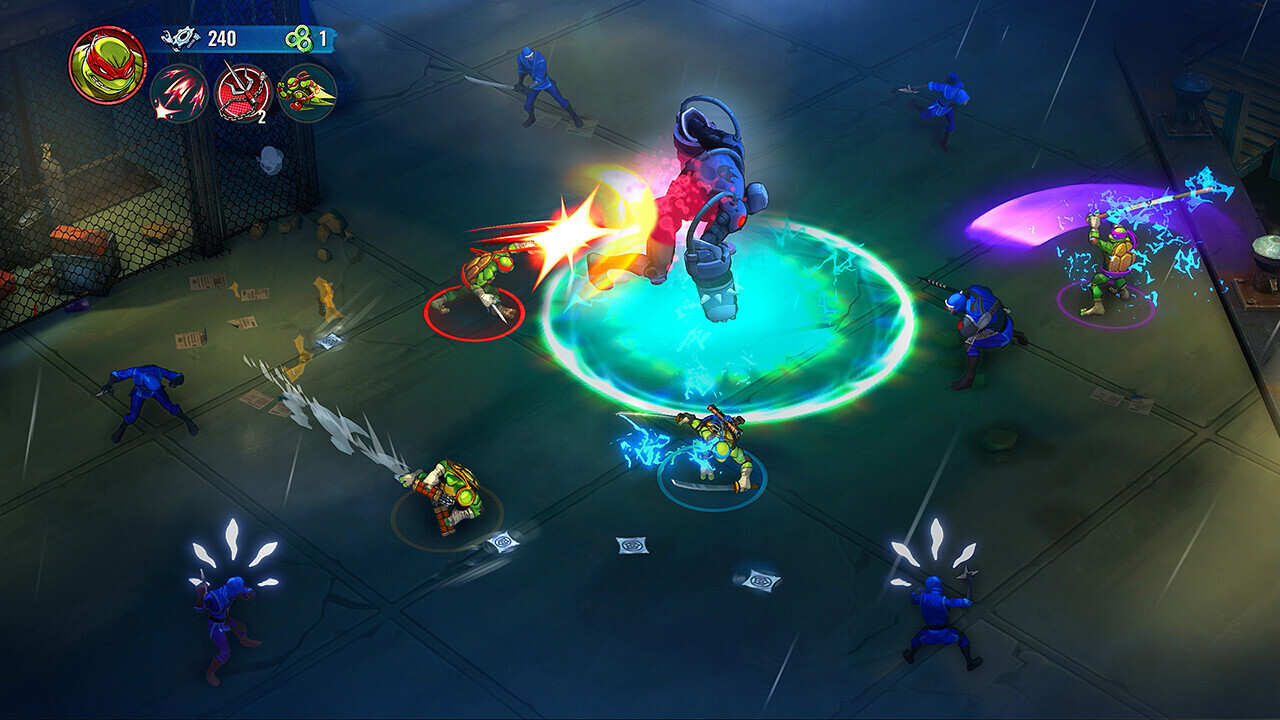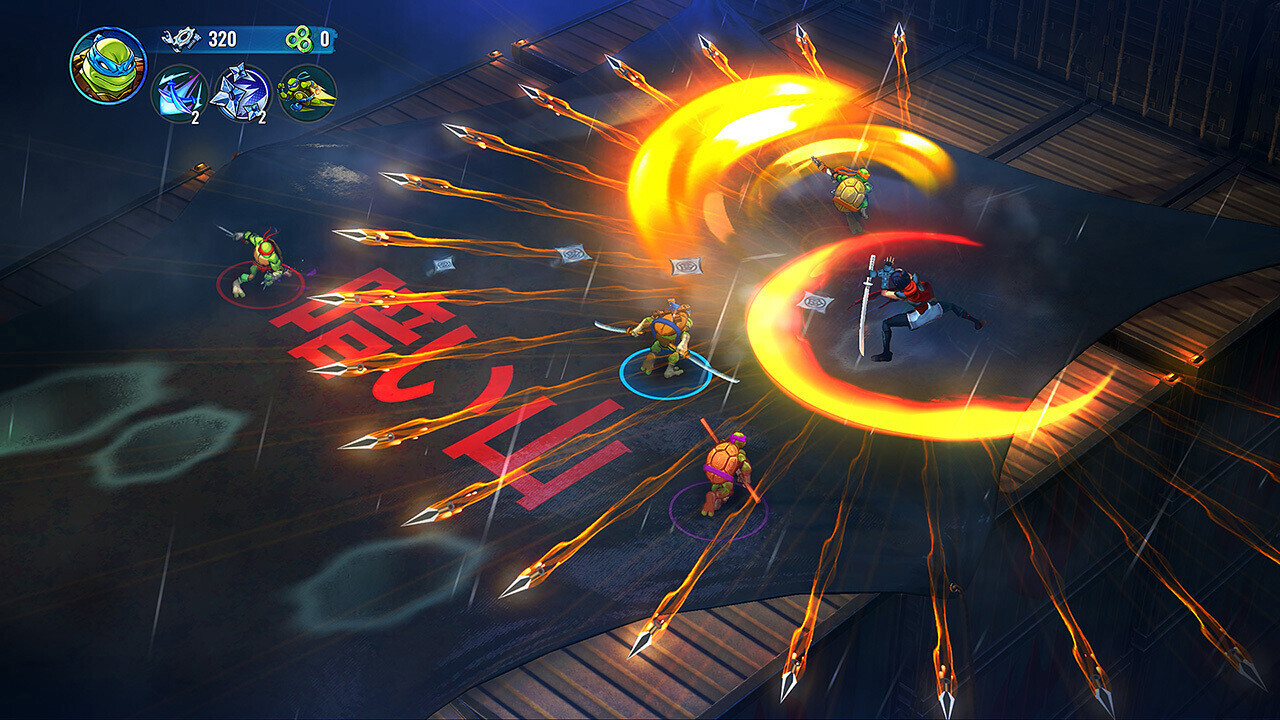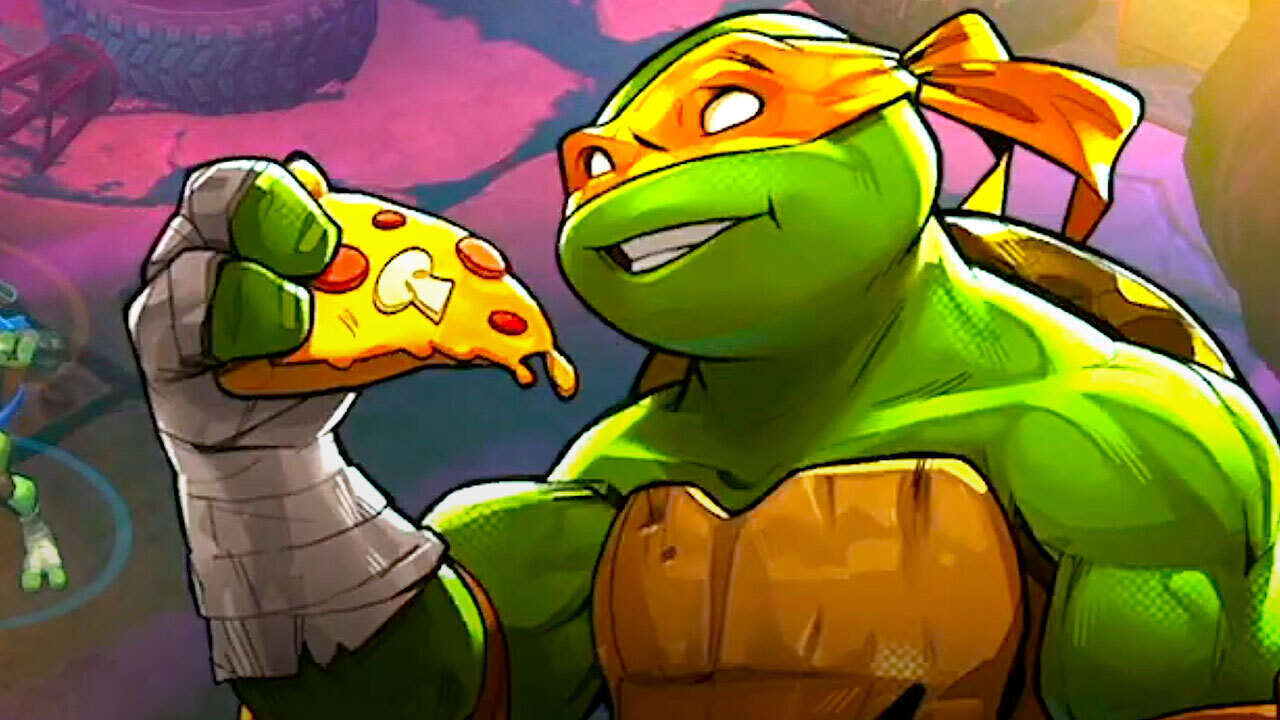As strange as the idea sounds–teenagers who are mutant turtles, who also happen to be ninjas–Teenage Mutant Ninja Turtles has been a wildly successful franchise going back to its origins as a comic book in the ’80s–so successful, in fact, that it spawned a legion of copycats, copy mice, frogs, sharks, and more. With that history of imitators in mind it’s funny to see Teenage Mutant Ninja Turtles: Splinted Fates act as such a direct clone of Hades, just with a TMNT coat of paint. Unlike Street Sharks or Biker Mice from Mars, though, this does an admirable job of capturing most of what makes its inspiration great.
As is tradition, Master Splinter has been kidnapped, and it’s up to the four turtles to battle through four levels of roguelite action to get him back. Each run starts in the sewers, moving room to room as you clear enemies and collect power-ups along the way. When you die, you are transported back to the turtle’s lair to regroup, buy a few upgrades, and start again.
Splintered Fates was originally a mobile game, but it was built with modern high-spec devices and access to controllers in mind. As a result, its solid core gameplay loop feels right at home on the Nintendo Switch. Delivering attacks before quickly dashing away to avoid damage generally feels fast and fluid. Intense fights near the end of a run can be a dizzying whirlwind as you prioritize targets and deliver blows in the small gaps in which enemies are vulnerable. Attacks quickly charge up a powerful special attack and a tool with a unique power, like Michelangelo’s taunt, which stuns and damages enemies in a small area of effect.
While it’s centered around a notoriously kid-friendly franchise, this certainly isn’t an easy action game geared toward the youngest or inexperienced gamers. Splintered Fates is a solid challenge. A full runthrough can take around 40-minutes depending on your stick skills and luck with power-ups, but, as befitting a roguelite, expect quite a few attempts to end in failure. It toes the line between being hard enough to be engaging, without veering into frustrating. If you prefer a more laid-back time with the Heroes in a Half-Shell, you can switch into easy mode at any time.
As you progress through each closed arena, taking out evil ninjas, giant rats, and laser-spewing robots as you go, you’ll be rewarded with a random assortment of perks after each encounter. That’s where the strategic elements come into play. You could opt for short-term boosts, like attack boosts, or lighting that comes down to strike your enemies at regular intervals. But you might be better off playing the long game, grabbing Dragon or Dreamer Coins, which won’t help you on the run in progress, but will make you incrementally and permanently stronger. Agonizing over a tough choice is fun, and it’s a thrill when you decide to go all-in on a run and it pays off.
Imitation is the sincerest form of flattery, and Hades is a great game–though it does mean the areas where Splintered Fate falls short tend to stick out more. The still images used during story moments, for example, are fine, but not nearly as memorable as the ones used to tell the tale of Zagreus and company. The taunts and jabs when you fight the same bosses on repeated runs are entertaining, but, massive jaws aside, Leatherhead just doesn’t have the same bite as Megaera.

If there’s an area where TMNT Splintered Fates stands alone, it’s in the quadrumvirate of main characters. Each turtle feels distinct thanks to their different weapons, unique attack patterns, and their varied special attacks. Donetello, the brainiac of the bunch, has a lot of range thanks to his bo staff and can put up a temporary shield, whereas hothead Raphael specializes in up-close DPS with rapid-fire attacks from his sai. It does a great job wrapping a playstyle around each character’s personality, and changing up which turtle you control keeps repeated runs feeling fresh.
Playing co-op with friends can be a chaotic blast, whether it’s online, or on the same couch. It’s the exact same experience as single-player, except with friends, which is great. Four turtles smashing and slashing their way through the campaign is a wild spectacle. The only issue here is the post-map reward structure. Each turtle takes turns picking their perks, which means a full four-person team spends a lot of time in menus, especially in the early half of a run where a full team can clear a room in under a minute. It’s a drag to the otherwise breakneck pace.
Unfortunately, co-op also shows just how big the gap is between the latest mobile devices and the dated hardware in the Nintendo Switch. Slowdown is an occasional nuisance in single-player, but when four turtles are all filling the screen with flashy attacks, the framerate drops considerably. There’s a cinematic mode that caps the frame rate at 30fps, but it seems like an extraneous feature given how much of a run seemed to be below that threshold. It’s not so severe as to ruin the experience, but it is frustrating to mistime a dodge and take damage because of it.

There’s a solid amount of variation from one run to another. The upgrades you acquire stack on top of each other and can lead to interesting builds, like one that covers enemies in a damaging ooze combined with another that increases the power of damage-over-time abilities. Each level has an assortment of mini-bosses that they will shuffle through, and the bosses will mix things up with different attacks and tactics. Karai, for example, might focus on throwing kunai at you between attacks in one fight, but switch to covering the ground in fire attacks the next. It’s enough to keep each run feeling fresh, even after almost two dozen attempts, though it can be frustrating when it feels like luck puts every fight on hard mode.
That increases even more after your first successful run. Without spoiling what happens in the endgame, you are encouraged to go through all of the levels more after you reach the end. This time, some areas will have additional exits that lead to harder variations of bosses, or implement modifiers that make getting through sections more difficult. It’s optional, but taking it on gives greater rewards of upgrade currencies, and, as the upgrades accumulate and you become more powerful, help keep the levels challenging.
It’s easy to reduce Teenage Mutant Ninja Turtles: Splintered Fate down to just a Hades clone with a TMNT skin, as I did previously. And while that description is pretty accurate, the sentiment doesn’t convey that a well-done take on a fantastic game can be a lot of fun. While the art and story don’t come near the lofty heights of Hades, it is nevertheless a blast to bash heads as one of the titular turtles, especially when you have friends fighting at your side. Technical issues aside, Splintered Fate is a fun time, and with a good variety to shake things up from run to run.
